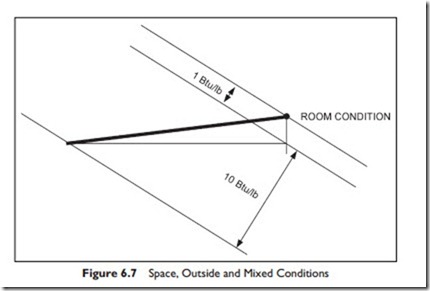System Performance Requirements
Before choosing a system, you need an understanding of the types of loads you want the system to manage. Typically, the summer cooling-loads will be the main determinant of the choice of unit. The heating loads are usually easily dealt with by choosing a suitable heater to go with the chosen unit. The summer loads, though, will be dependent on several, somewhat interrelated factors:
Outside summer design temperature. This affects the cooling load in three ways:
Interior load—The interior load is calculated using the outside temperature plus solar heat gain acquired due to heat transfer through the fabric of the building.
Outside air temperature—The load from the outside air temperature will also partly determine the cooling load of the outside air that is being brought into the building for ventilation.
Effectiveness of the refrigeration system—If the refrigeration system is air- cooled, the outside temperature will influence the effectiveness of the refrigeration system.
Outside summer design humidity. The outside design humidity will be a factor in the ventilation air load and the removal of moisture from any air that leaks into the building. Cooling tower performance is also directly affected by the humidity; performance falls as humidity rises.
Inside summer design temperature and humidity. The warmer and damper the inside is allowed to be, the smaller the difference between inside and outside, hence the lower the load on the system. This is particularly important when you are making system choices.
Slight under-sizing, which is cheaper to buy, means that occasionally the design temperatures will be exceeded. However, when the unit is slightly under-sized, it will be running nearer full load for more of the time. Depending on the situation, this may be the most economical choice.
Inside summer generation of heat and moisture. These will be added to the building loads to establish the total loads on the system.
Summer ventilation requirements. This is the ventilation for people, typically based on ASHRAE Standard 62.1, 2004 plus any additional ventilation for specific equipment. The higher the ventilation requirements, the greater the load due to cooling and dehumidifying the outside air that is brought in.
Once these basic criteria are established, load calculation can be done. Depending on the situation, summer cooling and winter heating loads may be estimated with fairly simple hand calculation methods for the peak-load summer-cooling and for the peak-load winter-heating. In other cases, an hour-by-hour computer simulation of the building may be done, in order to assess peak-load and intermediate-load performance.
The following example illustrates some of the issues for system performance.
A building has the following conditions:
The design room condition is 75°F and 50% relative humidity. The outside design condition is 95°F and 40% relative humidity.
The sensible heat load is 200,000 Btu/h. Sensible heat is heat that causes change in temperature.
The moisture heat load, or “Latent heat” is 20,000 Btu/h. Latent heat is the energy that is absorbed by water which causes the water to evaporate.
To calculate the loads, first divide the latent load by the sensible load. This provides us with the percentage of sensible heat that must be removed from the system.
For example, if the latent load is 20,000 Btu per hour (Btu/h) and the sensible load is 200,000 Btu/h, the ratio would be 1/10. With an all-air system, the air supply must be at a temperature and moisture content that requires 10 times as much sensible heat as latent heat to reach room temperature. We can plot a line on which the air supply must be to meet the design room condition.
You can easily plot this on the psychrometric chart as is shown in Figure 6.7.
First, note the enthalpy of the air at the desired room condition. Draw a vertical line downward from the room condition.
Mark on the line where the enthalpy line is 1 Btu/lb less than room conditions.
From this point, draw a horizontal line to the left. Mark off where the enthalpy is 10 Btu/lb less.
Draw a line from here to the room condition.
This illustrates that, for the supply air to meet the designed room condition, it must be supplied at some point on this line. If it is supplied close to the designed room-condition the volume will have to be large.
The calculation of heating loads is relatively straightforward, but cooling- load calculation is more challenging, due to the movement of the sun and changing loads throughout the day. Calculating heating and cooling loads is the subject of the ASHRAE Course Fundamentals of Heating and Cooling Loads3.
Decision Factors for Choosing Units
When choosing equipment, several factors must be balanced.
The initial cost to purchase and install versus the ongoing cost of operation and maintenance. Most heating and cooling systems reach peak load very occasionally and then only for a short period of time. Most of the time, the equipment is operating at loads much below peak. Equipment either improves in efficiency at lower load—a characteristic of many boilers—or it falls—a characteristic of many refrigeration units. When choosing refrigeration equipment, it can be very worthwhile to consider the part-load performance. It is in the part-load performance evaluation that hour-by-hour computer simulations become a really necessary tool.
Load versus capacity. Note that we have been talking about “loads,” but when you look in manufacturers’ data sheets, they talk about “plant capacity.” “Loads” and “capacity” are the same issue, but loads are the calculated building requirements, while capacity is the plant equipment’s ability to handle the load. When purchasing packaged plant equipment, the plant capacity often does not exactly match the calculated building loads. One of the challenges for the designer is choosing the most suitable package, even though it does not exactly match the calculated building loads. This issue is illustrated in the following section on rooftop units.
